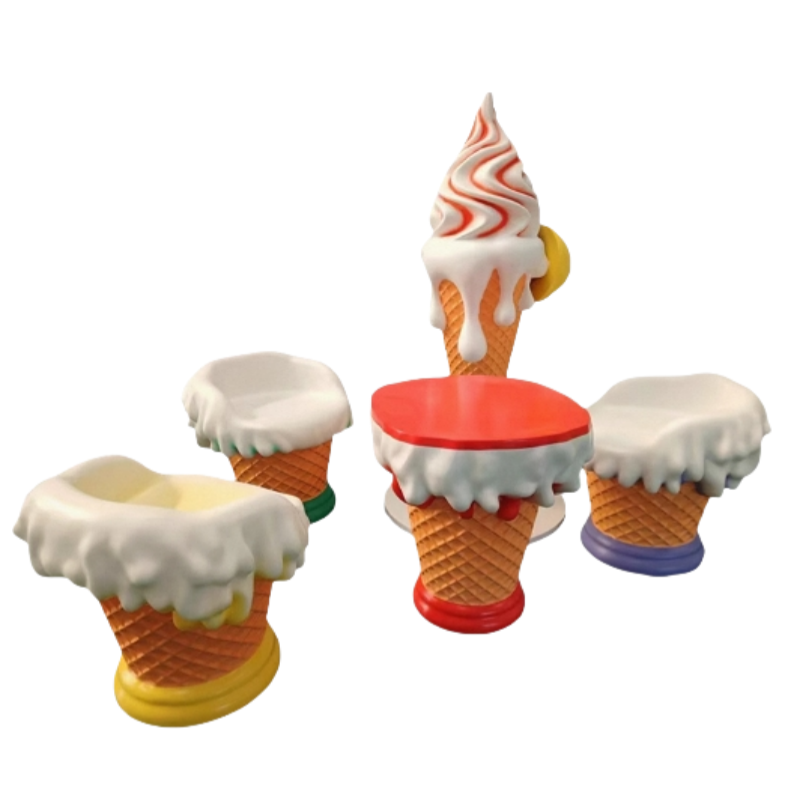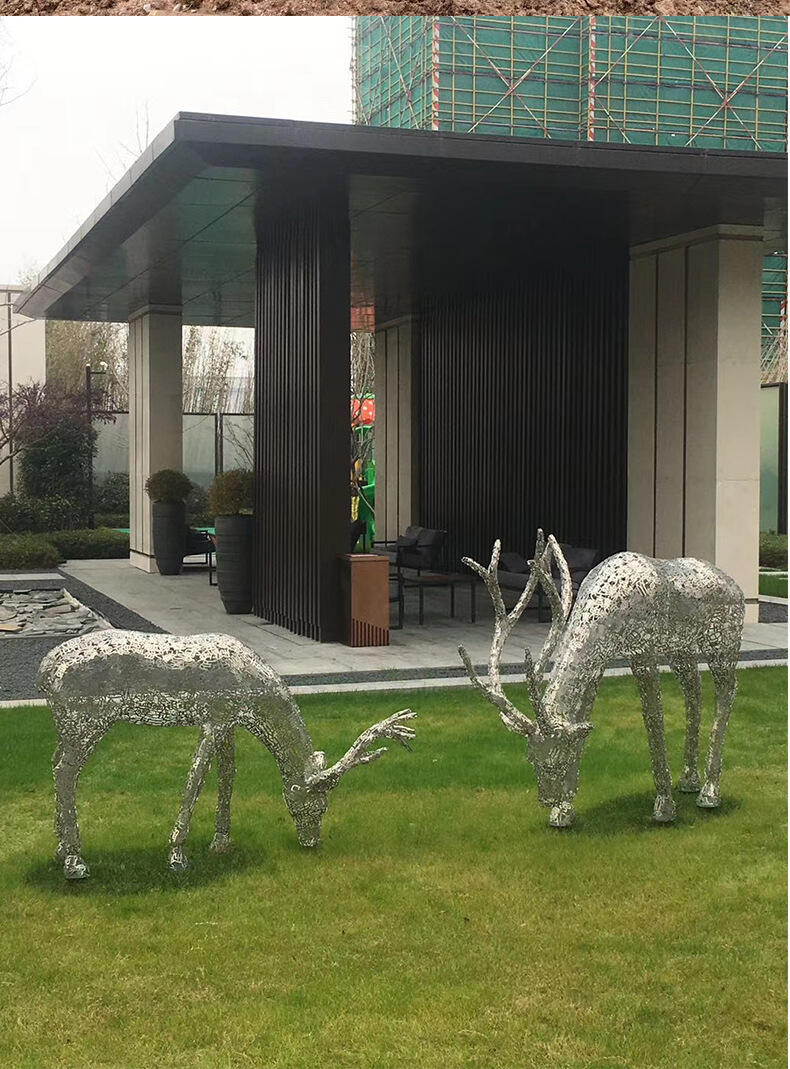Selección de las Dimensiones Ideales para Elementos Artísticos al Aire Libre
Jardín esculturas de fibra de vidrio se han convertido en opciones cada vez más populares para elementos decorativos exteriores, transformando paisajes ordinarios en espacios artísticos cautivadores. El tamaño de estas esculturas desempeña un papel crucial para crear el impacto visual deseado y mantener la proporción adecuada dentro del entorno de tu jardín. Comprender cómo seleccionar las dimensiones correctas garantiza que tu espacio exterior logre el equilibrio perfecto entre expresión artística y funcionalidad práctica.
Comprensión de la Escala en el Diseño de Jardines
Principios Fundamentales del Tamaño de Esculturas
Al incorporar esculturas de fibra de vidrio al jardín en tu espacio exterior, la escala se convierte en un factor primordial. El tamaño de la escultura debe complementar, y no abrumar, su entorno. Los jardines grandes pueden acomodar piezas más grandes, mientras que los espacios íntimos se benefician de instalaciones más pequeñas y delicadas. Diseñadores paisajistas profesionales suelen recomendar que las esculturas de fibra de vidrio en el jardín ocupen aproximadamente entre el 15% y el 20% del área visible para mantener la armonía visual.
La distancia de visión también influye en la selección del tamaño. Las esculturas destinadas a ser apreciadas desde lejos necesitan dimensiones más grandes para conservar su impacto visual, mientras que las piezas colocadas junto a senderos o en áreas de asientos íntimas pueden tener un tamaño más moderado. Considere las líneas de visión naturales y los ángulos de observación al determinar la escala adecuada para sus esculturas de fibra de vidrio en el jardín.
Equilibrio Proporcional con los Elementos Circundantes
Su escultura debería establecer un diálogo con las características existentes del jardín, como árboles, arbustos y elementos arquitectónicos. Una regla general sugiere que las esculturas de fibra de vidrio para jardín no deberían superar dos tercios de la altura de las estructuras permanentes circundantes para mantener la armonía visual. Por ejemplo, si tiene un muro de jardín de 9 pies de altura, esculturas de hasta 6 pies de alto crearían un equilibrio atractivo.
Considere también los cambios estacionales en su jardín. A medida que las plantas crecen y el follaje cambia, el tamaño percibido de su escultura puede variar. Elija dimensiones que funcionen bien durante todo el año, teniendo en cuenta tanto los paisajes invernales dormidos como el exuberante crecimiento veraniego.
Categorías de tamaños populares para jardín Aplicaciones
Piezas artísticas de pequeña escala
Las esculturas pequeñas de fibra de vidrio para jardín, que suelen medir entre 0,3 y 0,9 metros de altura, destacan por crear puntos focales íntimos dentro de rincones de jardín o jardines en contenedores. Estas piezas más pequeñas funcionan especialmente bien en patios, a lo largo de senderos del jardín o como elementos decorativos cerca de zonas de asientos. Su tamaño manejable permite reubicarlas fácilmente y reorganizarlas según la temporada, ofreciendo flexibilidad en el diseño del jardín.
Estas esculturas de tamaño modesto suelen representar temas detallados como animales, formas abstractas o motivos botánicos. Su escala las hace perfectas para crear múltiples puntos de interés a lo largo del jardín sin abrumar el espacio. Las esculturas pequeñas de fibra de vidrio también resultan ideales para jardines urbanos, balcones o áreas exteriores reducidas donde es esencial optimizar el espacio.

Piezas Medianas de Impacto
Las esculturas de fibra de vidrio para jardín de tamaño mediano, que van de 3 a 6 pies, sirven como puntos focales atractivos manteniendo dimensiones accesibles. Estas piezas funcionan excepcionalmente bien en bordes mixtos, camas centrales del jardín o como elementos de transición entre diferentes zonas del paisaje. Su presencia sustancial llama la atención sin dominar completamente el espacio.
Esta categoría de tamaño ofrece versatilidad en cuanto a tema y estilo, permitiendo diseños tanto figurativos como abstractos. Las esculturas medianas de fibra de vidrio para jardín pueden anclar eficazmente 'habitaciones de jardín' o crear puntos visuales de parada a lo largo de líneas de vista prolongadas. Son particularmente efectivas cuando se colocan en la intersección de senderos del jardín o como piezas centrales en jardines circulares.
Consideraciones para Instalaciones de Gran Escala
Requisitos de Espacio e Impacto Visual
Las esculturas grandes de fibra de vidrio para jardín, que superan los 6 pies de altura, requieren una consideración cuidadosa del espacio y entorno. Estas piezas dramáticas necesitan un área circundante suficiente para ser adecuadamente apreciadas, generalmente un mínimo de 20 pies de espacio libre de visión en todas las direcciones. El impacto de las esculturas grandes va más allá de su proximidad inmediata, influyendo a menudo en todo el carácter del jardín.
Al colocar esculturas grandes de fibra de vidrio en el jardín, considere crear áreas designadas para observarlas o puntos de descanso donde los visitantes puedan apreciar plenamente la escala y los detalles de la pieza. Estas instalaciones sustanciales suelen beneficiarse de iluminación estratégica para realzar su presencia durante las horas nocturnas y prolongar su impacto visual durante todo el día.
Factores Técnicos e de Instalación
Las esculturas de fibra de vidrio más grandes para jardín requieren un soporte de cimentación robusto y sistemas de anclaje adecuados. El proceso de instalación se vuelve más complejo conforme aumenta el tamaño, por lo general necesitando asistencia profesional. Considere las rutas de acceso para la entrega e instalación al seleccionar piezas más grandes, asegurándose de que puertas, portones y caminos del jardín puedan acomodar las dimensiones de la escultura.
La resistencia al clima adquiere mayor importancia en esculturas de fibra de vidrio grandes para jardín, ya que están expuestas a mayores fuerzas ambientales. Un refuerzo adecuado y materiales de alta calidad son esenciales para garantizar durabilidad e integridad estructural, especialmente en regiones con condiciones climáticas severas.
Consideraciones de mantenimiento según categorías de tamaño
Requisitos de cuidado según el tamaño
Diferentes tamaños de esculturas de fibra de vidrio para jardín presentan distintos desafíos de mantenimiento. Las piezas más pequeñas suelen requerir limpieza más frecuente debido a su proximidad con los residuos al nivel del suelo y salpicaduras de los sistemas de riego. Las esculturas medianas y grandes pueden acumular excrementos de aves y contaminantes atmosféricos, lo que requiere limpiezas periódicas profesionales para mantener su apariencia.
El área superficial de las esculturas de fibra de vidrio para jardín más grandes las hace más susceptibles al desgaste ambiental, requiriendo inspecciones regulares en busca de signos de degradación o daño. Establecer un programa de mantenimiento basado en el tamaño y la exposición ayuda a preservar la apariencia y la integridad estructural de la escultura con el tiempo.
Estrategias de Protección Estacional
Las necesidades de protección contra el clima varían según el tamaño de la escultura. Las piezas más pequeñas pueden trasladarse o cubrirse fácilmente durante condiciones climáticas severas, mientras que las esculturas más grandes de fibra de vidrio para jardín requieren estrategias de protección más elaboradas. Considere rutinas de mantenimiento estacionales que aborden vulnerabilidades específicas del tamaño, como la exposición al viento en piezas altas o daños por heladas en instalaciones a nivel del suelo.
La inversión en medidas protectoras adecuadas, como fundas personalizadas o refugios temporales, ayuda a prolongar la vida útil de sus esculturas de fibra de vidrio para jardín independientemente del tamaño. Evaluaciones regulares de mantenimiento garantizan la detección temprana de posibles problemas antes de que se vuelvan significativos.
Preguntas Frecuentes
¿Cómo determino el tamaño adecuado de escultura para mi espacio de jardín?
Considere el área total de su jardín, las distancias de visualización y las características existentes. Una pauta general es asegurarse de que la escultura ocupe no más del 20 % del espacio visible, manteniendo relaciones proporcionales con los elementos circundantes. Mida cuidadosamente el espacio disponible y considere crear una maqueta de cartón para visualizar el impacto antes de tomar una decisión final.
¿Pueden las esculturas grandes de fibra de vidrio para jardín resistir vientos fuertes?
Sí, cuando se instalan correctamente con sistemas de anclaje y cimentaciones adecuadas. Las esculturas grandes deben diseñarse teniendo en cuenta los cálculos de carga por viento y pueden requerir instalación profesional para garantizar estabilidad. La construcción en fibra de vidrio ofrece una excelente relación resistencia-peso, lo que la hace adecuada para instalaciones exteriores de mayor tamaño.
¿Cuáles son las consideraciones de transporte para esculturas de diferentes tamaños?
Las esculturas pequeñas y medianas normalmente pueden transportarse en vehículos estándar, mientras que las piezas más grandes pueden requerir servicios de transporte especializados. Siempre verifique las rutas de acceso y los espacios libres antes de la compra, y considere cualquier permiso necesario para la instalación de esculturas grandes. Puede ser necesario contar con manipuladores profesionales de arte para piezas que excedan los 6 pies en alguna dimensión.
Tabla de Contenido
- Selección de las Dimensiones Ideales para Elementos Artísticos al Aire Libre
- Comprensión de la Escala en el Diseño de Jardines
- Categorías de tamaños populares para jardín Aplicaciones
- Consideraciones para Instalaciones de Gran Escala
- Consideraciones de mantenimiento según categorías de tamaño
- Preguntas Frecuentes


